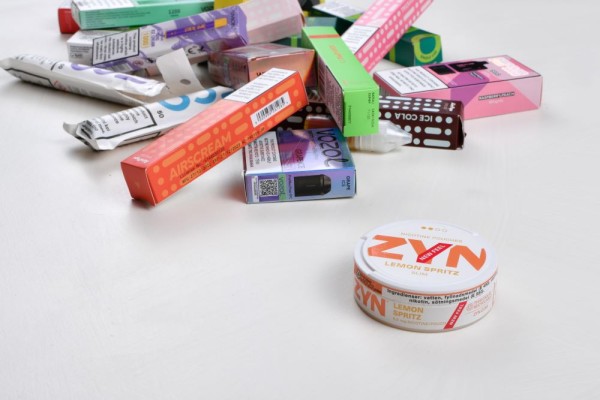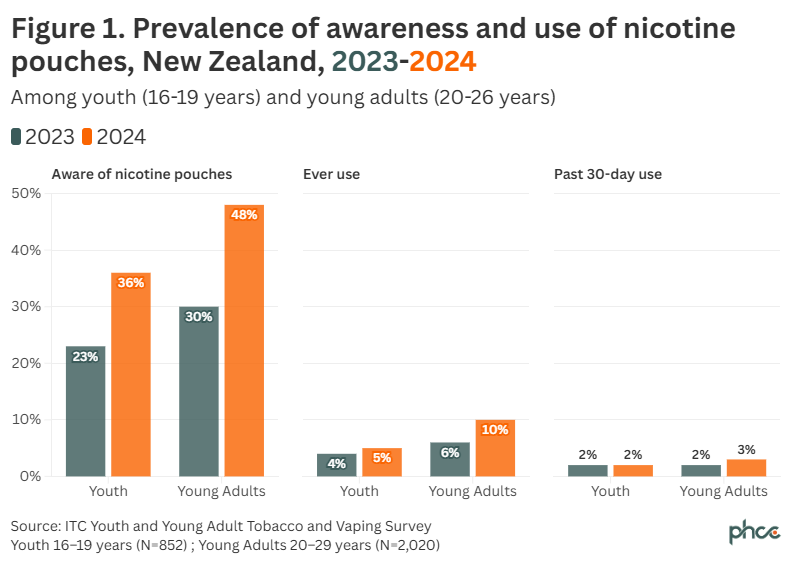Summary
This Briefing presents evidence from new research on youth and young adults' awareness and use of oral nicotine pouches like “Zyn” in Aotearoa New Zealand. It also outlines young people’s views on the Government’s proposal to legalise their sale. Even though these products are not permitted for sale in Aotearoa, more than a third of youth and nearly half of young adults surveyed had seen or heard of them, and use increased among young adults between 2023 and 2024. In-depth interviews revealed that many young people were curious about nicotine pouches, driven by social media promotions and perceptions of lower harm compared to vaping. However, most did not support the proposal to legalise their sale, citing concerns about youth-targeted marketing and the risk of increased nicotine addiction among their age group.
The sale of oral tobacco and nicotine products is currently not permitted in Aotearoa New Zealand, except for Medsafe-approved nicotine replacement therapies. However Associate Minister of Health, Casey Costello, proposes legalising sales of products such as nicotine pouches and Swedish snus, arguing they “should be available as options for people who smoke.”1 The Ministry of Health advised against this policy,2 citing a lack of evidence that oral tobacco and nicotine products help people stop smoking, and noting concerns that novel nicotine products are being marketed to youth rather than people who smoke--points also raised by health experts.3-6 Despite this opposition, Cabinet has agreed in principle to change the law and allow sales of these products.
To date, debates about the risks and benefits of legalising oral tobacco and nicotine products have relied almost entirely on overseas evidence. Now, Aotearoa data are available for the first time. This Briefing summarises key findings from the International Tobacco Control (ITC) Youth and Young Adult Survey about awareness and use of nicotine pouches (e.g. the Philip Morris product Zyn) among New Zealanders aged 16-29 years; and findings from in-depth interviews with diverse16- to 18-year-olds undertaken in late 2024 as part of the Adolescent Friendships and Lifestyles 2.0 study.
Awareness and curiosity
Although they are not legal to sell in Aotearoa, awareness of nicotine pouches was relatively high among Aotearoa youth (16–19 years) and young adults (20–29 years), with 36% and 48% respectively reporting they had seen or heard of these products during the August/September 2024 survey period. These estimates represent a statistically significant increase in awareness from 2023 levels of 23% and 30% respectively (Figure 1 below, Table A1 in Appendix).
In-depth interviews conducted at around the same time revealed that many of the 39 participants aged 16 to 18 had seen nicotine pouches in TikTok and Instagram posts, which positioned the products as appealing, cool and less harmful than vaping. Social media content had shaped their perceptions and piqued their curiosity. For example, one young woman said:
Zyns are going to be the new vaping […] a lot of influencers use them, which I think definitely contributes a lot [to youth interest]. But I also think…it's the flavours. I think that, because they’re seen as so much better than vaping, you know, it's like, ‘oh, try this new product that's better for you’. It’s just like, ‘okay, I want to have that now.’
Product use
Returning to the survey findings, ever use of nicotine pouches among youth was 4% in 2023 and 5% in 2024—a difference that was not statistically significant. Among young adults, however, there was a statistically significant increase in ever use, from 6% in 2023 to 10% in 2024.
Past 30-day use was less prevalent: 2% among youth and 3% among young adults in 2024 (no significant change since 2023).
The survey did not investigate how young people were accessing pouches, but in-depth interviews suggest the products are being imported for personal use via international webstores, which is legal under New Zealand law.
Reasons for use
Pooled 2024 ITC data from NZ, Canada, USA and England showed that, among the 425 youth who had used nicotine pouches in the past 30 days, common reasons for use included ‘curiosity/to try something new’ (29%), ‘easy to use without people noticing’ (24%), and ‘for fun/I like it’ (23%). Reported use of pouches to quit smoking cigarettes or to stay quit was less common--12% and 16%, respectively.
Views on legalisation
In-depth interview participants were asked whether they supported or opposed a law change to allow oral nicotine products to be sold in Aotearoa. Although some thought the products might help people quit smoking or vaping, most opposed legalisation, saying widespread availability of nicotine pouches would “get a lot more people addicted” and “cause more harm.” One young man commented:
“This is for sure targeting younger people and, like, children. … you'd probably want to fight not to introduce this.”
Another pointed out the contradiction between the government cracking down on youth vaping, while proposing to expand the nicotine market by introducing more products currently targeting youth.
Discussion
Awareness of, and curiosity about, nicotine pouches is relatively high among young people in Aotearoa, likely reflecting heavy promotion of these products on social media by tobacco companies and paid influencers.7-9
Although use of nicotine pouches among young adults is increasing in Aotearoa, regular use is uncommon among young people, suggesting the current law disallowing sales of oral nicotine products may be having a protective effect. In contrast to the Associate Minister’s rationale for introducing these products, international evidence suggests use is primarily recreational in this age group rather than to stop smoking.
We conclude that current marketing strategies are reaching youth and young adults in Aotearoa, the age group that international studies suggest are most likely to use these products.10 Legalisation is likely lead to greatly increased marketing efforts and availability, in turn increasing visibility, use, and nicotine addiction among young people.
What this Briefing adds
- Awareness of nicotine pouches increased significantly among youth (16-19 years) and young adults (20 – 29 years) between 2023 to 2024, despite their sale being disallowed in Aotearoa.
- Ever use of nicotine pouches rose significantly among young adults, from 6% in 2023 to 10% in 2024, while ever use among youth remained at 4% to 5%.
- Most youth interviewed opposed the proposal to legalise sales of oral nicotine products, citing concerns about youth-targeted marketing and the potential for increased nicotine addiction.
Implications for policy and practice
- Current policy settings may offer some protection against regular use of nicotine pouches among youth and young adults in Aotearoa.
- Any legislative changes regarding oral nicotine and tobacco products should be grounded in independent evidence, not tobacco industry claims, and consider potential impacts on youth.
- There is an urgent need to expand monitoring of emerging nicotine products and research to understand the potential risks and benefits of these products.
Authors details
Dr Jude Ball, Co-Director of ASPIRE Aotearoa Research Centre, and Department of Public Health, University of Otago Wellington | Ōtākou Whakaihu Waka Pōneke
Jessica Reid, University of Waterloo, Canada, project manager of the ITC Youth & Young Adult Smoking and Vaping study
Prof David Hammond, University of Waterloo, Canada, principal investigator of the ITC Youth & Young Adult Smoking and Vaping study
Assoc Prof Anaru Waa, ASPIRE Aotearoa Research Centre, and Department of Public Health, University of Otago Wellington | Ōtākou Whakaihu Waka Pōneke
Dr Michaela Pettie, ASPIRE Aotearoa Research Centre, Pathology and Biomedical Science, University of Otago Wellington | Ōtākou Whakaihu Waka
Prof Janet Hoek, Co-Director of ASPIRE Aotearoa Research Centre, and Department of Public Health, University of Otago Wellington | Ōtākou Whakaihu Waka Pōneke
Appendix
Table A1: Prevalence of awareness and use of nicotine pouches, New Zealand, 2023 - 2024
| Measure | Youth 16–19 years (N=852) | Young Adults 20–29 years (N=2,020) |
|---|
| | 2023 | 2024 | 2023 | 2024 |
| Aware of nicotine pouches | 23% | 36% | 30% | 48% |
| Ever use | 4% | 5% | 6% | 10% |
| Past 30-day use | 2% | 2% | 2% | 3% |
Data source: ITC Youth and Young Adult Tobacco and Vaping Survey


